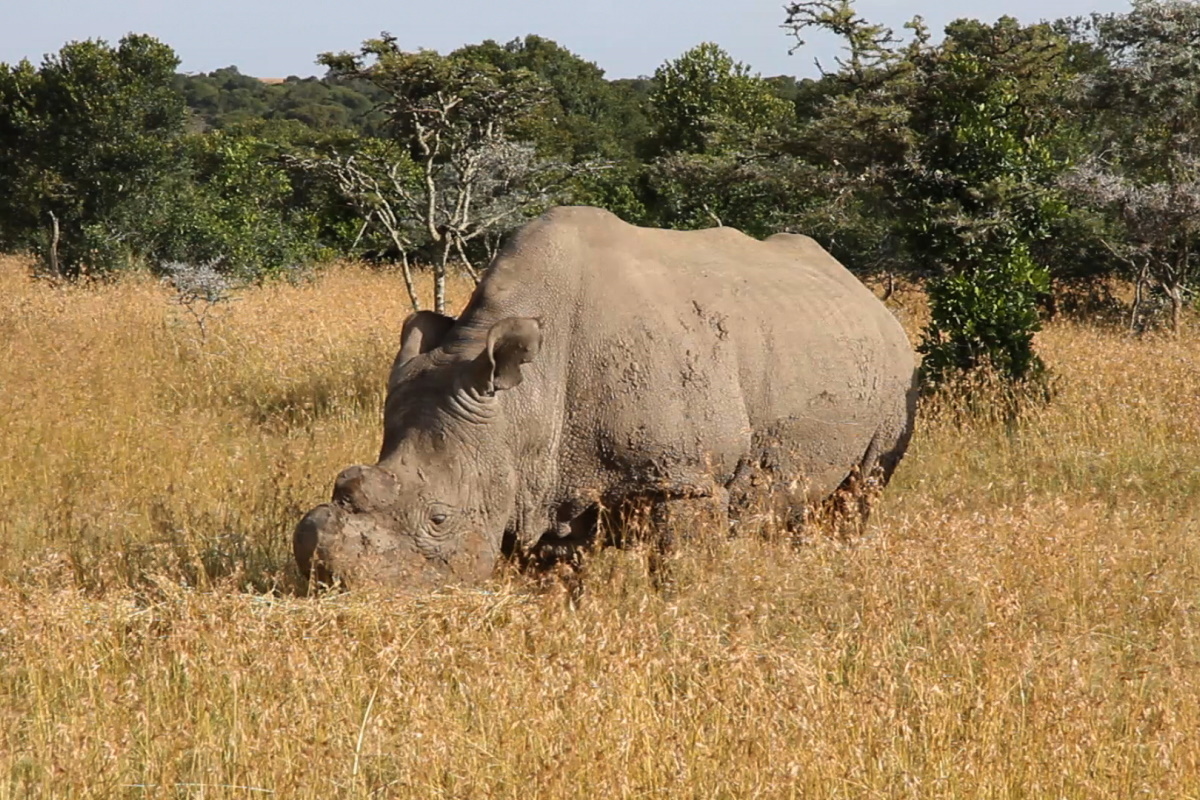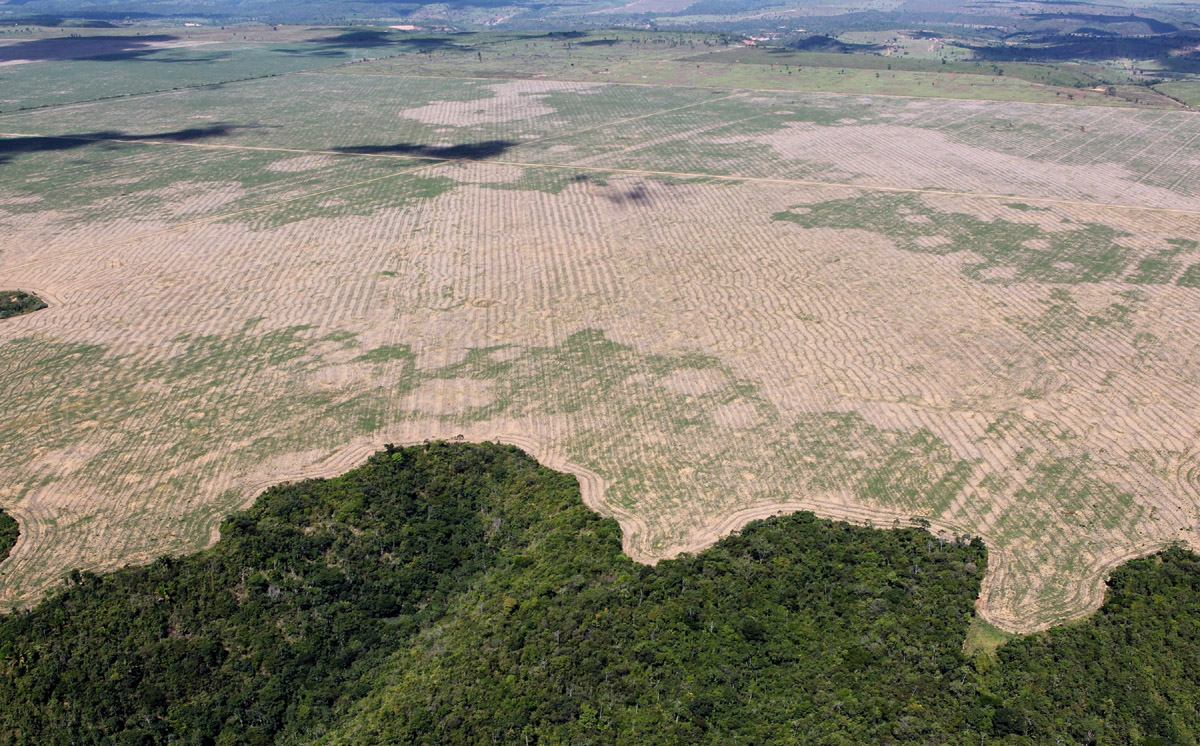
One of four Northern white rhinos, a critically endangered subspecies, which were translocated to Ol Pejeta Conservancy, Kenya, to live in a semi-wild state with keepers and armed security. Since the move in 2009, two of the four have died. Michael Dalton-Smith, Digital Crossing Productions, via Wikimedia Commons
This story is part of Covering Climate Now, a global journalism collaboration strengthening coverage of the climate story. It is an expanded and updated version of an article first published by Texas Climate News last December. TCN editor Bill Dawson contributed additional reporting to this version.
Last October, the U.N. assessed the world’s progress toward meeting 20 biodiversity targets that nearly 200 nations meeting in Japan had adopted a decade earlier in 2010. It was a dispiriting report card.
Despite growing concern about dangerous climate disruption and its close connections to ecosystem degradation and species loss, conservation efforts under the biodiversity pact failed to meet 14 of the targets. Only six others approved under the Convention on Biological Diversity (CBD) were partly met. It was, a representative of a leading U.K. conservation group told New Scientist, “a massive, if not catastrophic, failure at all levels.”
Now, another CBD conference is approaching in October, where world leaders will consider adopting a draft set of updated targets to “reverse biodiversity loss and its impact on ecosystems, species and people.” One target would dramatically commit signatories to protect and conserve at least 30 percent of the earth’s surface by 2030, focusing on areas particularly important for biodiversity.
Proponents are calling for the new iteration of the CBD accord to be a history-making Paris-style agreement for biodiversity. Indeed, the inextricable ties of biodiversity loss and climate disruption, the subject of the 2015 Paris pact, have become even more compelling over the past decade, researchers say. “Accelerating climate change is becoming the overarching threat to the functionality of entire ecosystems,” a faculty member at Germany’s Eberswalde University for Sustainable Development told The Guardian this month.
The urgency of biodiversity conservation and restoration has been underscored by new research findings released in just the past few weeks.
A satellite survey by Global Forest Watch found that forest loss accelerated in 2020, even as the pandemic slowed the world economy and greenhouse emissions – almost 100,000 square miles of forest disappeared, a 7 percent increase over 2019. That included a 12 percent increase in destruction of rainforests, especially important for carbon storage and biodiversity conservation, with the causes including huge wildfires on several continents.
Last month, an international team of researchers published a study of the forest-saving impact of conservation measures from 2000-15 at nearly 50,000 protected areas covering 1.5 million square miles worldwide. Forest losses, they found, were still experienced in 70 percent of the protected areas.
A new extinction wave
With particular regard to the loss of plant and animal species driven by forces such as habitat destruction and climate change, those recent findings only add to a growing body of scientific evidence about the biodiversity crisis since the 2010 CBD agreement was adopted.
Almost 10 years ago, biologists suggested Earth was entering a sixth mass extinction – defined as a loss of more than three-quarters of its species in a geologically short interval. Such events have happened only five times in the past 540 million years or so.
Five years ago, additional research confirmed that this sixth mass extinction was, in fact, under way. The work further noted that the number of species that became extinct in the past century normally would have taken between 800 and 10,000 years to disappear.
Then, a June 2020 paper in the Proceedings of the National Academy of Sciences (PNAS) noted that the extinction rate of terrestrial vertebrate species is significantly higher than prior estimates. Some 500 species have populations of less than 1,000 individuals and face likely extinction within the next two decades if nothing changes. That would bring total losses to an equivalent of those that would have taken place naturally across 16,000 years. Birds have the most species at risk, followed by amphibians, mammals, and reptiles. Further, experts predict a sharp increase in the current rapid vertebrate extinction rate in the future.
The news is no better for plants. A report in September from The Royal Botanic Gardens, Kew, in the United Kingdom warns that destruction of natural landscapes has put two in five of the world’s plant species at risk of extinction. This news looks all the more alarming given that nearly 4,000 species of plants and fungi were scientifically named for the first time as recently as 2019.
The Kew report states: “The World Checklist of Vascular Plants, the most comprehensive and regularly updated species list of its kind, records around 350,000 accepted species, of which 325,000 are flowering plants. Ten years ago, scientists thought that the vast majority of flowering plants had been described and named. But the subsequent stream of species revealed to science suggests there are many more to find, as do the experiences of botanists undertaking fieldwork in the tropics today.”
The causes
Previous extinction events resulted from catastrophic alterations of the environment – massive volcanic eruptions, depletion of oceanic oxygen, an asteroid colliding with Earth. It took millions of years after each of these events for the numbers of species to recover to pre-event levels.
Today, humans are the main driver of extinctions. Most plant loss, for example, results from destruction of wild habitat to create farmland. Over-harvesting of wild plants, building of infrastructure, introduction of invasive species, pollution and, increasingly, climate change represent important drivers as well.

Deforestation in Maranhão, Brazil, due to illegal timber extraction. Felipe Werneck – Ascom/Iba via Wikimedia Commons
Many extinctions have occurred just since our ancestors developed agriculture, about 11,000 years ago.
For animals, drivers of species extinctions include habitat loss and fragmentation (most of the 177 species of large mammals lost more than 80 percent of their geographic range in the last century), illegal trade, overexploitation, introduced domestic and wild species, pollution, and climate change.
The authors of the PNAS paper say this sixth mass extinction may be the most serious environmental threat to civilization, because it is irreversible. Acceleration of the crisis is certain, they add, given continued rapid growth in human numbers and consumption rates.
“We’re never going to solve this problem as long as the human enterprise keeps expanding,” says co-author Paul Ehrlich of Stanford University’s Center for Conservation Biology.
“Humanity is increasing in terms of population size and per capita consumption, and we are already at a level where we’re killing off the biodiversity of the planet,” Ehrlich said in an interview with Texas Climate News. “It all ties back to human activity, directly and dramatically.”
The costs
Apart from the tragedy of a plant or animal permanently disappearing – including iconic species such as polar bears – extinctions have a suite of consequences for humans.
Some of those newly discovered plants and fungi, for example, could help feed us. Scientists currently record more than 7,000 edible plant species, but only some 400 are considered food crops. The effects of climate change on agricultural practices and standard crops make the search for alternative crops more urgent.
Many plants also have medical value. At least 720 plant species currently used in medicine face risk of extinction, and we may lose others before even discovering their potential. Those new species identified in 2019, for example, included a Texas sea holly species whose relatives can treat inflammation.
Plants and fungi also could serve as sources of bioenergy, contributing to reducing both carbon emissions and energy poverty. The potential of fungi in particular is largely unexplored, as scientists suspect that more than 90 percent of fungi species remain unknown.
The legal and illegal trade in wildlife decimating many species has been linked to the Covid-19 pandemic, the PNAS paper notes. Scientists caution that continued destruction of wild habitat and unchecked wildlife trade almost surely presage more pandemics in the future.
Perhaps most significant, overall decreased biodiversity lessens the natural world’s ability to provide valuable ecosystem services such as water filtration, control of pests, and pollination. Extinctions change entire ecosystems, with the loss of one species potentially having far-reaching effects.
For example, disappearance of keystone species can trigger extinction cascades, or a series of extinctions throughout an ecosystem. Analysis shows that the disappearance of the Steller’s sea cow from the Bering Sea’s Commander Islands in the mid-1700s likely resulted from overhunting of sea otters a decade earlier. By feeding on sea urchins, which eat kelp, sea otters played a key role in maintaining the kelp forests on which sea cows depended for shelter and food. Large apex predators such as wolves and sharks also are known to be key to maintaining the health of their associated ecosystems.
“The costs of extinction are basically breakdown of the systems that support us,” Ehrlich says.
The cures
In previous periods of climatic and environmental change, resilient landscapes helped maintain terrestrial biodiversity. Unfortunately, recent research shows landscape resilience in North America at its lowest since end-Pleistocene megafaunal extinctions, due to an expanding human footprint and changing climate.
Further, the 196-nation Convention of Biological Diversity reported in August, the world has failed to meet a single target set by the treaty of that name for stemming the destruction of wildlife and ecosystems.
A November 2020 study provides a glimmer of hope: The alarming estimates of decline in vertebrate species are driven by less than 3 percent of vertebrate populations. The researchers found extreme declines in 16 of the taxonomic-geographic systems in the Living Planet Index, including birds and freshwater mammals in the Indo-Pacific and reptiles in North, Central, and South America, with loss occurring disproportionately in larger animals. Remove the not quite 3 percent of vertebrate species in free-fall, they note, and the picture changes dramatically. The fact that losses are concentrated also provides specific targets for conservation efforts.
Ehrlich cautions that the problem requires a big-picture approach, though. “The only thing we can do quickly is change our consumption patterns, but if we don’t start humanely changing our population patterns, that isn’t going to help either,” Ehrlich says. “We’ve known for years that if we keep dumping greenhouse gasses into the atmosphere, we’re in trouble. There is no way to continue a reasonable way of living for people on the planet unless we change how we deal with the problems of climate, biodiversity, toxification, and agriculture. We don’t have that much time.”
The most important thing that individuals can do, he adds, is become politically active. “We’ve got to educate people and get them out there to take action, rather dramatic action. What do you do about the growing population? The data show that if you empower women, birth rates go down. So, the first place to start is to fight for women’s rights.”
Gerardo Ceballos of the Universidad Nacional Autónoma de México’s Ecology Institute, lead author on the PNAS paper, along with Ehrlich and other colleagues, established a global initiative to try and turn things around called Stop Extinction. It aims to raise awareness and give people a role in changing the current trajectory.
Humans are the primary cause of the sixth mass extinction, and we also can be part of the cure.
Melissa Gaskill, an independent journalist in Austin, is a contributing editor of Texas Climate News. Bill Dawson is TCN’s founding editor.
